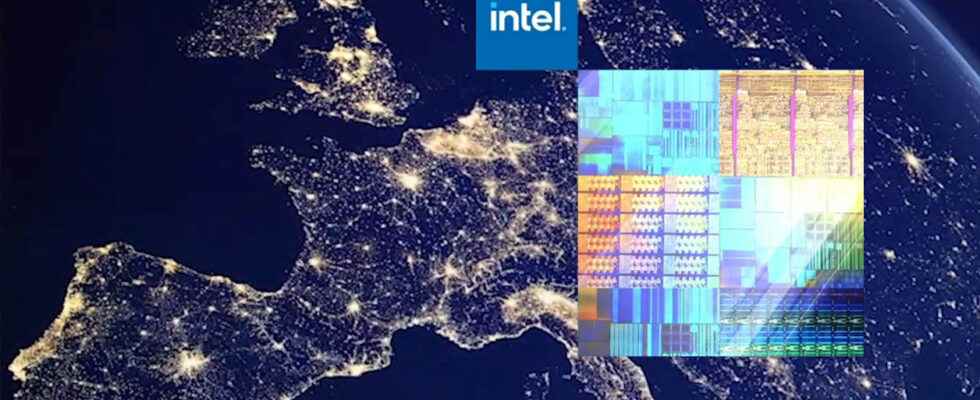In Germany the factories, in France the advanced research center: if clichés die hard, it is because they are sometimes verified by example. Intel CEO Pat Gelsinger has just announced a massive investment plan in Europe – 80 billion over 10 years – which spreads over several countries of the continent various key elements of the design, manufacture and integration of semiconductors. -drivers.
For this first round investment of 33 billion euros, it is Germany that wins the industrial “jackpot” with the formalization of the choice of Magdeburg for the construction of the two latest generation fabs. They will be the second heart of Intel’s European chip production, with the site in Ireland, already in operation since 1989.
A former city in East Germany, Magdeburg is the capital of the state of Saxony-Anhalt, between Lower Saxony and Brandenburg. It is only 230 km from Dresden, headquarters of the factories of Global Foundries (formerly AMD), and therefore benefits from an already solid ecosystem of suppliers. The German site will cost 17 billion euros and is expected to produce Intel’s most advanced chips for the continent. The huge investment promises no less than 3,000 new employees in addition to construction and supply chain jobs during its operation.
The other big winner of this first round is Ireland, where Intel already manufactures 10 nm chips (Intel node 7). The Leixlip site will take advantage of $12 billion expansion work to increase production capacity and move to the next node, called Intel 4 (7 nm Intel sauce).
France “brain” of R&D, but without an announced budget

If we add the 17 billion for Germany and the 12 billion for Ireland, there is a little money missing for the “more than 33 billion” of this first round. Well the missing 4.5 billion goes to Italy. Taking advantage of the takeover of Tower Semi (LINK) with which the Franco-Italian group STMicroelectronics has strong ties, Intel will invest in the “back-end” part, that is to say the one that comes after the burning of the chips on silicon wafers (inspection, tests, cutting, combination of dies, etc.)
In addition to this major industrial investment, there is a doubling of Intel’s laboratory in Gdansk, Poland, as well as an increase in Intel’s investment in the Spanish laboratory of the Barcelona Supercomputing Center.
And France? On paper, Pat Gelsinger has announced that the Saclay plateau, near Paris, should host the main European center for Research & Development and Intel chip design. A project centered around high performance computing and artificial intelligence which would result in the hiring of more than 1,000 engineers. No German or Italian-style industry, but an “intelligence” laboratory which does not benefit, for the time being, from any quantified investment. Without a factory behind, it is logical that the sum is much lower than those deployed in our neighbors.
Not charity, but a need for diversity

A legitimate question that arises is “ why would a company like Intel invest so much in Europe rather than in the USA? “. If the full answer is very long – the key to understanding is to be found in the current semiconductor “crisis”. The Huawei-gate, the closures of chip factories in 2020 due to the pandemic, the explosion of demand in many markets (auto, IT, but also household appliances, navigation, etc.), factory accidents ( Texas, Japan, South Korea) or even potential geopolitical instabilities (TSMC in Taiwan threatened by China) have highlighted our dependence on too few suppliers. And to Asia. ” 80% of semiconductors come from Asia, so we want to build a more resilient and balanced supply chain “, announced Mr. Gelsinger during his speech.
And the European thirst to return to the technological race, in particular through the European Chips Act, suggests advantages and investments for Intel, which is seen here as a “savior”. Quite rightly, the billions he promises to invest are indeed enough to stimulate ” strengthening a next-generation ecosystem as Mr. Gelsinger promises. An opinion shared by Ursula von der Leyen, President of the European Commission, who aims to see “ 20% of (world) chip production comes from Europe. Double the current proportion in a market that will double in the coming years “, she assures.
Read also: Intel wants to take on the role of Western champion in semiconductor production
She adds that Europe’s ambitions are not to produce low-end chips, but chips that ” go beyond the 3 nm barrier “. An ambition that contradicts the European automobile manufacturers who have not failed in recent months to want to focus on chips dedicated to the automobile or aeronautics where Europeans are the strongest.
On paper, Mrs von der Leyen is probably right to dispense with their opinion: European companies have been among the hardest hit by the shortage of semiconductors because of their lack of knowledge of the functioning of this market (too many intermediaries, cancellation of orders that cannot be made up, etc.).
Also see video:
Also see video:
If Intel does not spare its investments in the USA, with recent announcements of investment in New Mexico or the future Gigafab of New Albany in the state of Ohio, the activation of an ecosystem under its control in Europe will make it, de facto, the Western champion of semiconductors that he announced he wanted to become last year when announcing his IDM 2.0 project – which aims in particular to open up its fabs to third parties.
Some might regret that it is not a European company. But to create a powerful and cutting-edge ecosystem so quickly, it seems that it is easier to choose a player of enormous size and with a single head. And it is not STMicroelectronics which could fulfill such a mission.
It now remains to see the first German fabs come out of the ground – production of which should begin in 2027 – and wait for the second part of the plan which will define and fix investments in France.
